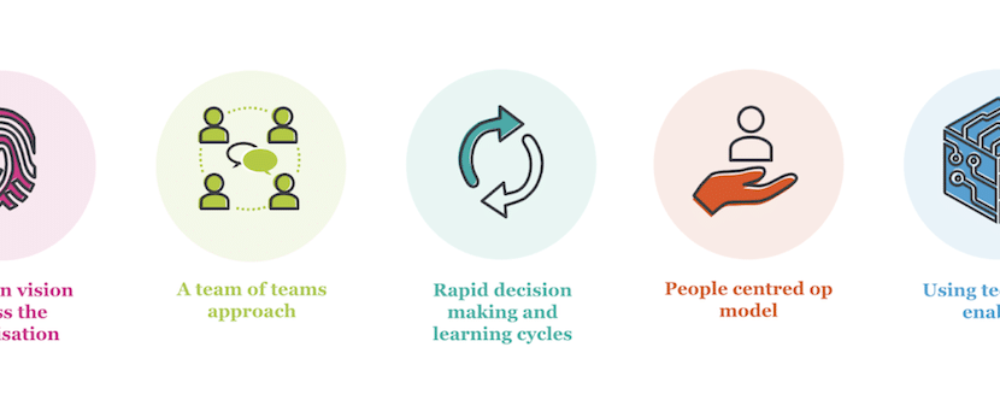In the first article in our series on subscription business models, we spoke about the need to change your business and operating model to drive growth and loyalty in your subscription offerings. This requires much more collaboration across functions and more cohesive communications to be successful, much like a race day Formula One team.
In this article, we explore in more detail what this means for your business functions and how to change the way you are organised in order to be more effective in a subscription economy.
Customer journey – from awareness to advocacy
What’s the difference between one-off products and subscriptions?
A one-off product offering is like a Formula One team developing their car in the off-season. Everyone has their job to complete the product, and they need to stay aligned. For example, if the engine dimensions are changed because the engine team has developed a new upgrade, the structures and aero teams need to be consulted about this but they will then work on their components separately, feeding relevant information to one another only if required. On practice runs and race day, however, they stand side-by-side watching the car perform and deciding if any tweaks need to be made together.
In the business world, to take customers from awareness to advocacy, you would typically consider the following steps to sell a one-off product:
- Market your brand
- Market your product, ideally by being as personalised as possible
- Drive consumers to purchase
- Process and deliver the order effectively, ensuring great service throughout
- Learn about what customers like, and feed this back into this process to make continuous improvements
Compare that relatively orderly process to the unpredictability of race day. On lap one the front wing of one car might be knocked off by their teammate, the mechanics then need to change it, the strategists now need to completely rethink the pit strategy, and the PR team need to prepare for the media frenzy which is about to follow.
Similarly, subscription customers can create unpredictability. They might start a free trial, join as a paying customer, upgrade their products, pause their subscription, restart it again, recommend a friend, and/or leave. Organisations need to be ready to manage these complex customer journeys.
The most flexible subscription models create a much shorter or even constant lead-to-cash (L2C) cycle for both business-to-consumer (B2C) and business-to-business (B2B) customers, the latter of which have undergone significant behavioural shifts in the last few years. The pass-off of a customer from one function to another, as in traditional revenue models, is not optimised to keep customers happy in a subscription economy. All functions now need to be constantly working together to keep customers happy and interested.
The risks of departmental disconnects to your subscription business
The customer experience can be severely impacted by inefficient service structures, where being shuffled between disconnected departments to resolve an issue often leads to frustration and increased churn. To mitigate this, self-service options for subscription management should be designed with a dual focus: to streamline the customer journey and to strategically reduce churn while also identifying opportunities for cross-selling and upselling.
In essence, subscription management should be viewed through the lens of e-commerce, where every interaction is part of a larger, customer-centric journey. By considering the customer’s perspective and needs at each step, companies can create a seamless, intuitive self-service experience that not only satisfies, but also anticipates customer requirements, encouraging loyalty and enabling growth.
This change is significant for an organisation and requires a rethink in the skillsets of employees within the contact centre, changes in R&R between sales, customer success and service and, in some cases, changes in pay and incentivisation models. This effort will pay off through a reduction in internal battling on customer ownership, and higher focus on delivering a great experience to consumers.
Breaking down silos to boost customer retention
Marketing & Sales
In a B2C environment, marketing and sales should already be one and the same thing but with subscription-based products this needs to be true in the B2B world too.
Customers are going through the evaluation and purchasing cycle each time they interact with the product, because they know they can always change or cancel their subscription if it isn’t working for them.
When introducing new features, there’s a unique chance to re-engage customers by presenting the product/service in a new light, better tailored to serve their needs. For this approach to truly resonate and be effective, it’s crucial that sales and marketing teams operate in close collaboration.
In an optimal scenario, this collaboration would take the form of cross-functional teams. These teams would not only concentrate on crafting compelling marketing narratives but also engage directly with customers. By doing so, they can gain valuable insights to inform the development of features that genuinely meet customer needs and expectations. This synergy between direct customer interaction and strategic marketing can elevate the customer experience, making each update feel like a personalised upgrade to their service.
Sales & Customer Service
On the other side of the sale, subscription customers are also interacting with Customer Success teams and self-service platforms much more than physical sales teams, because they operate in a world where their consumption and payment of the product can be much more fluid. There is plenty to learn about what the customer likes and does not like which can be used in cross-sell and upsell conversations. We do see this today with Customer Success teams taking on responsibility for renewals but with more flexible subscription models, these handoffs should be reduced by having a team like Customer Success involved from the start.
This sounds subtle but it is significant. Organisations with a yearly renewal already see their customer success as a sales function but imagine taking this a step further. If you have a contact centre, when customers get in touch, multi-skilled reps should be ready, not only, to handle complaints, but to adjust packages on the fly, and train customers on features they might not be aware of.
Marketing and Product
Following on from seeing subscription management as e-commerce, we have another tighter merge of capabilities. The product itself is your greatest marketing channel to retain existing customers.
Digital products should have in-built marketing capabilities to recommend different components or encourage usage of lesser-used features. For physical products, behavioural data such as shifting delivery dates or swapping between product lines frequently should be used to market the most effective products to consumers.
Product usage data is nothing new in renewals but with more flexible subscription models, it is now critical to success. Using deeper behavioural insights, product teams can drive specific marketing interventions to ensure the customer is offered the right thing at the right time in the right way.
The Power of Feedback and Customer-Centric Sales Strategies in the Subscription Economy
In the subscription economy, establishing robust feedback loops to prevent mis-selling is crucial. A one-time purchase gone wrong may create detractors, which is undesirable, but the impact is often contained as the customer may not need to make a repeat purchase, and the revenue for that year has already been secured.
However, in the world of flexible subscriptions, the stakes are higher. If customers find that the product doesn’t suit their needs, they can easily cancel their subscription. Take, for example, a meal box subscription. If a company offers a pasta meal box, pressuring customers to opt for two meals a week when they only want pasta for dinner once a week can significantly increase the likelihood of churn.
Sales strategies should be designed to prioritise long-term customer retention over short-term gains. Incentivising sales teams based on the duration of customer subscriptions, such as aiming for a minimum of a year’s commitment, would therefore align better with the company’s interests. After all, securing a customer for a weekly box over a year is far more beneficial than pushing two boxes a week onto subscribers who then cancel after one month. This approach not only ensures a more predictable revenue stream but also fosters customer satisfaction and loyalty.
Equally, sales learn a lot in their conversations with clients and in order to keep products current and sell the right thing marketing, sales, and product need to be talking regularly. There should be ways to collect and share customer feedback in real-time and a regular cadence of meetings to align on what customers like. Product development needs to be responsive to feedback to stay current and ahead of competitors.
Embracing integration
In conclusion, the transition to a subscription-based business model is not merely a shift in how products are sold; it’s a fundamental change in how companies operate and engage with their customers. From the initial awareness to the advocacy stage, every touchpoint with the customer is an opportunity to reinforce value, build loyalty, and drive growth.
Marketing, sales, customer service, and product teams must forge a seamless alliance, sharing insights and feedback in real-time to tailor offerings that resonate with customers’ evolving needs. Sales strategies must prioritise long-term engagement over short-term metrics, incentivising teams to foster enduring relationships rather than fleeting transactions.
By embracing this integrated approach, organisations can create a robust ecosystem where customer satisfaction is paramount, and every function drives towards a singular goal: delivering a product experience that not only meets but anticipates customer needs, honing the company’s competitive edge in the fast-paced subscription economy.
Ready to ignite your subscription business? Let’s talk! Our team of experts would love to help you optimise and grow your subscription business, ensuring you stay ahead in the race for customer loyalty and revenue.
Clarasys is an international business consulting firm.
Please visit the firm link to site






